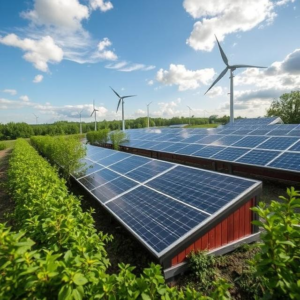How Green Technology is Leading the Fight Against Climate Change
The urgency of combating climate change is evident in every part of the world. Green technology is playing a vital role in mitigating the effects of climate change and paving the way for a sustainable future. In this article, we explore how green technology is transforming industries and contributing to a cleaner planet.

What is Green Technology?
Green technology refers to innovations that help reduce environmental harm by promoting sustainability and energy efficiency. These technologies focus on reducing pollution, conserving resources, and generating clean energy, helping to address the challenges posed by climate change.
The Role of Green Technology in Combating Climate Change
1. Renewable Energy Solutions
Green technology’s greatest impact on climate change comes through renewable energy. By shifting away from fossil fuels to cleaner energy sources, green tech is significantly reducing greenhouse gas emissions.
- Solar Power: Affordable and scalable, solar energy is one of the fastest-growing renewable energy sources.
- Wind Energy: Wind farms contribute to clean energy production with minimal environmental impact.
- Hydropower: Harnessing the power of water, hydroelectric plants provide stable, renewable electricity.
By adopting these renewable technologies, countries can cut their carbon footprints and reduce dependency on non-renewable resources.
2. Energy Efficiency Innovations
Improving energy efficiency is another critical aspect of green technology in the fight against climate change.
- LED Lighting: Energy-efficient lighting consumes far less power than traditional incandescent bulbs.
- Electric Vehicles (EVs): By replacing gasoline-powered cars with EVs, emissions from transportation are significantly reduced.
- Smart Thermostats: These devices help control energy use more efficiently, lowering consumption in homes and offices.
These innovations reduce the need for excessive energy production, minimizing carbon emissions.
3. Sustainable Agriculture Technologies
Agriculture contributes significantly to climate change through practices like deforestation and the use of chemical fertilizers. Green technologies in agriculture are working to reduce emissions and promote sustainability.
- Precision Farming: Technologies like drones and sensors help farmers use water, fertilizers, and pesticides more efficiently.
- Vertical Farming: This method of growing crops in stacked layers reduces land and water use, making it a sustainable alternative to traditional farming.
Sustainable agriculture is essential to reduce emissions from the agricultural sector while ensuring food security.
Innovative Green Technologies Making a Difference
4. Carbon Capture and Storage (CCS)
Carbon capture and storage (CCS) technology captures carbon dioxide from power plants and other industrial processes before it can enter the atmosphere. This innovation helps reduce the impact of industries that are difficult to decarbonize, such as cement and steel production.
- How CCS Works: Carbon dioxide is captured, transported, and stored underground in geological formations, preventing it from contributing to global warming.
CCS could be a game-changer in meeting global climate goals by reducing industrial emissions.
5. Waste-to-Energy Technologies
Waste-to-energy (WTE) technologies help address two problems at once: waste disposal and energy production.
- Anaerobic Digestion: This process turns organic waste into biogas, which can be used to generate electricity.
- Waste Pyrolysis: This technology converts non-recyclable waste into valuable energy, reducing the reliance on landfills.
By turning waste into renewable energy, these technologies help decrease pollution and promote a circular economy.
Green Technology’s Contribution to Global Climate Goals
Countries worldwide are committed to limiting global temperature rise, as outlined in the Paris Agreement. Achieving this goal requires a collective effort to reduce carbon emissions, and green technologies are essential in this fight.
- Renewable Energy Transition: Green technologies are helping nations shift from fossil fuels to clean energy sources.
- Energy Efficiency: Widespread use of energy-efficient appliances and vehicles contributes to achieving global climate targets.
The combined efforts of governments, businesses, and consumers to embrace green technologies will be crucial in mitigating the impacts of climate change.
The Future of Green Technology in Climate Action
The future of green technology is filled with promise. As innovation continues, we can expect more advanced solutions to emerge, helping to fight climate change even more effectively.
- Advanced Battery Storage: New breakthroughs in battery technology will make renewable energy more reliable.
- Sustainable Materials: As we move toward a circular economy, new materials that are both sustainable and energy-efficient will play a key role in climate action.
Green technology will continue to evolve, offering new ways to reduce carbon footprints and combat climate change.
Conclusion
Green technology is essential in the global effort to combat climate change. From renewable energy sources to energy-efficient solutions and sustainable agriculture practices, these technologies are leading the charge in reducing carbon emissions and promoting sustainability. With continued innovation and global collaboration, green technology can help us move toward a future where climate change is no longer an existential threat.